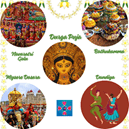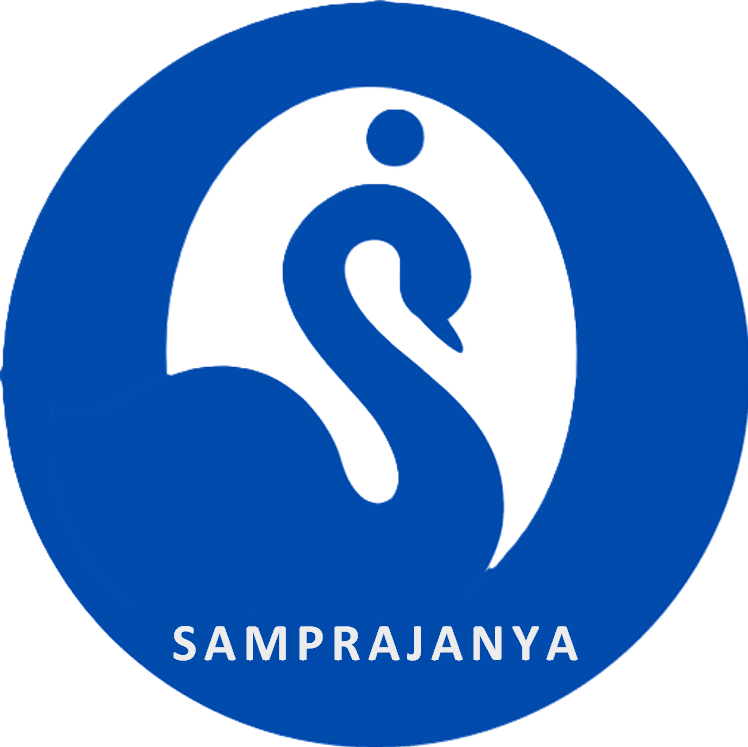
Navaratri is celebrated to honour, revere, and glorify the feminine aspect of creation. This primordial force, the Parashakti, the force underlying the universe that maintains and sustains creation, is worshipped as the Divine Universal Mother, as goddess Shakti in her various forms. Interestingly, Navaratri and Yoga have much in common. Both aim at realization of the Self and union with the Cosmic Self. Practicing yoga can help individuals connect with the spiritual aspect of Navaratri on a deeper level.
The festival spans nine nights and ten days and the tenth day is celebrated as Vijayadashami. Nine forms of the Divine Mother are worshipped, one for each day of Navaratri. The forms, the celebration, the rituals, and the underlying story behind them, all bear great significance. The tenth day is also celebrated to commemorate the victory of dharma when Lord Rama is said to have killed Ravana, the rakshasa king of Lanka. Navaratri, variously known as Dasara is celebrated enthusiastically in many different ways in the many states of India and by Hindus worldwide. These ten days can be spiritually and physically demanding when it is both a time for feasting and fasting. From the physiological point of view, the start of a season means many changes in weather conditions that the body has to adjust to – from temperature changes to viral infections. Fasting, which is usually prescribed as a part of the religious regimen, helps the body to successfully adapt to the changing conditions and environment. The kriyas or Shat karma of yoga are a great way to detoxify the body and make it ready for the Navaratri rituals.
Spirituality in Navaratri and Yoga
For a spiritual aspirant, the predominant energies are very powerful and are conducive to spiritual growth, and rejuvenation. This is the time for introspection, contemplation, and meditation, when one can consciously rid oneself of disturbing tendencies, and enervating desires and therefrom, evolve and transcend. The three main forms of the Divine Mother – Durga, Lakshmi, and Saraswathi – are said to be representative of the three Gunas in us, Tamas, Rajas, and Sattva respectively. Navaratri is a favourable time to tune in to the divine energies, to bring about balance, and equanimity.
Yoga and Navaratri
Both Navaratri and Yoga have deep spiritual roots. While Navaratri is a celebration of the divine feminine energy, Yoga aims at union with the divine Self. Practicing yoga can help individuals connect with the spiritual aspect of Navaratri on a deeper level and help maintain physical fitness, flexibility, and stamina as well. Yoga and meditation being mindfulness-based practices, can enhance mental clarity and focus, which are important during Navaratri for deepening one’s devotion and concentration during prayers and rituals. Whether the requirement is for long periods of sitting for puja, or the energy, stamina, and flexibility that garba dancing demands, Yoga can greatly help to cope with the additional demands on the body, mind, and spirit during these ten days. Incorporating yoga into the Navaratri routine can be a holistic approach to wellness and spirituality. This can lead to a sense of inner balance and strength.
Navaratri is a time when the energies of the goddess are believed to be very active. Yogic practices aim at balancing and harnessing these energies within the body. Yogic, tantra, and religious texts mention and describe the Granthi, roughly translating to “psychic knots” present in the subtle bodies. The Lalita Sahasranamam, and Soundaryalahari, which are routinely chanted in many households daily, describe these in great detail.
It’s interesting, though not surprising, that most Hindu festivals are closely linked to major astronomical events. Hindu festival days are not randomly chosen dates. The events are auspicious because they occur on days when there is a convergence of cosmic energies that support spiritual practices. Four Navaratri, corresponding to the equinoxes and solstices, occurring at the beginning of the four important seasons, are celebrated every year in India.
Navaratri – Culture and Tradition
Navaratri is a time to integrate cultural and spiritual practices. And there is no dearth in the variety of traditions and rituals in the practices. The colourful processions of the world-famous Mysore Dasara, the Navaratri Golu (dolls arrangement) in individual households in Tamil Nadu, the Bathukamma tradition of Telangana, garba, and dandiya dancing in Gujarat, the famous Ramlila in Delhi with its own dedicated ground, the Durga pandals in Kolkata, these are only a few ways that showcase and highlight the richness of our cultural heritage. The festivities are yet another way to bring people together and feel the oneness.
Navaratri celebration is of great significance in terms of rejuvenation of both the physical and spiritual aspects of life. Let us all put our hearts and souls into this beautiful and meaningful celebration of Navaratri and obtain the grace of the Divine Mother!

